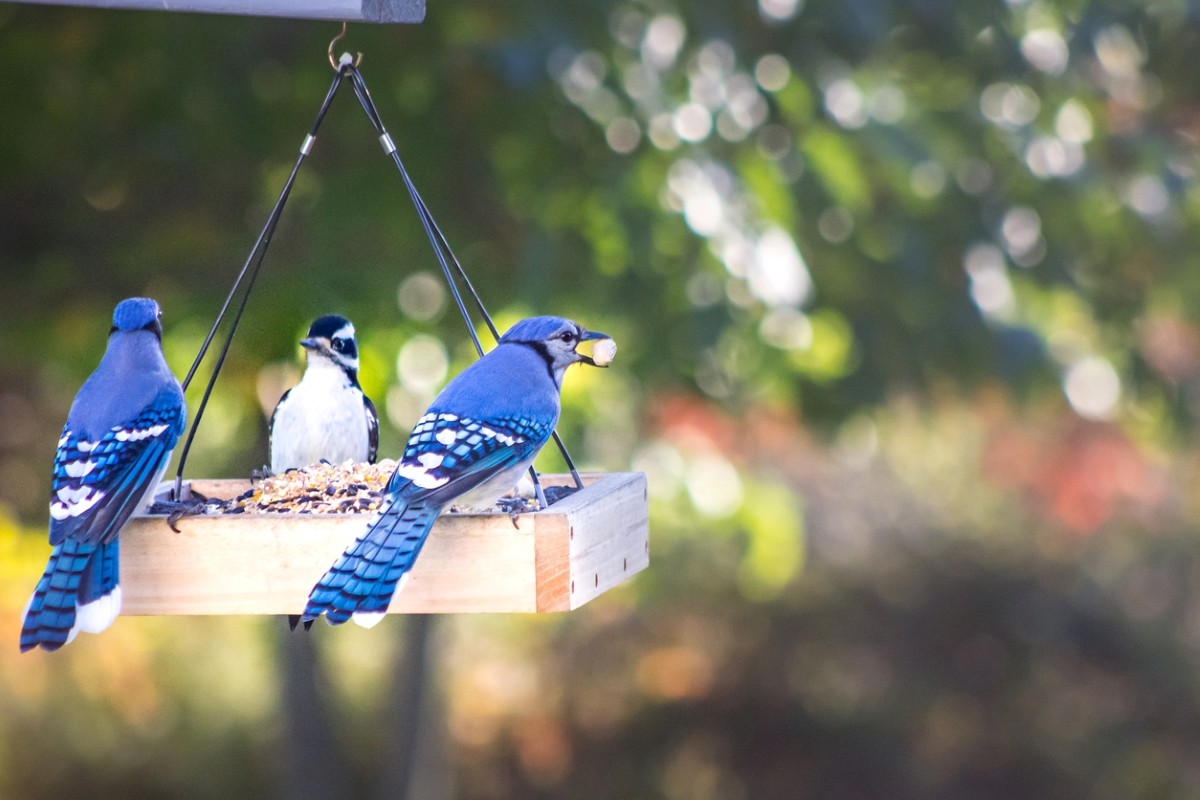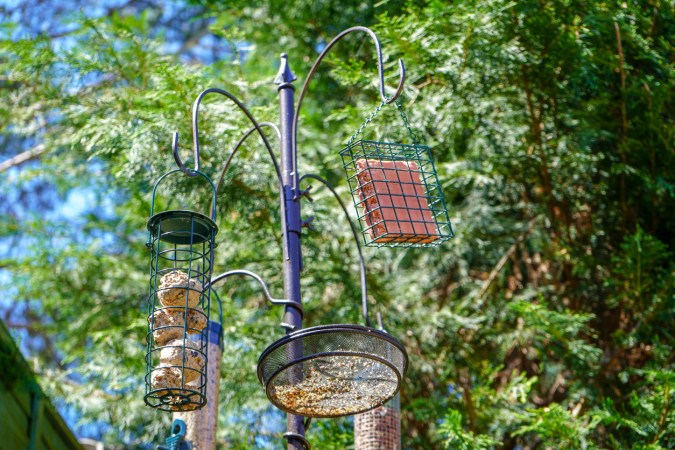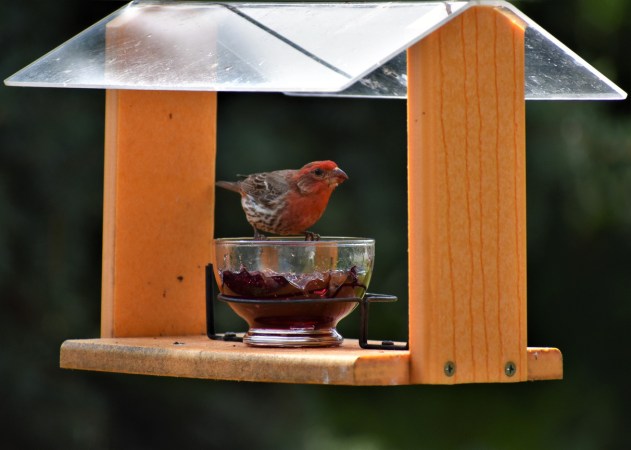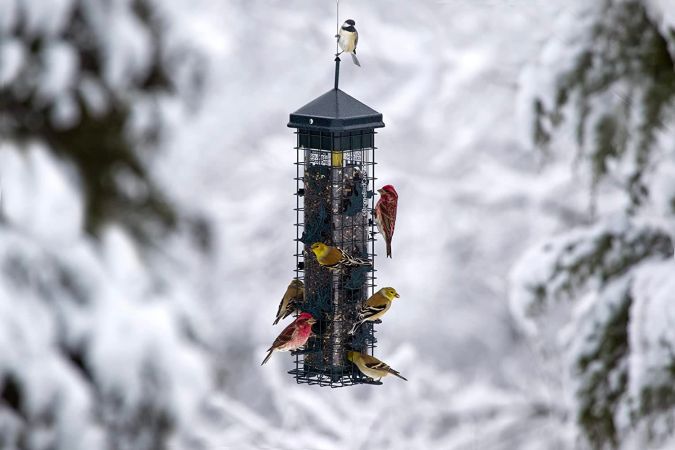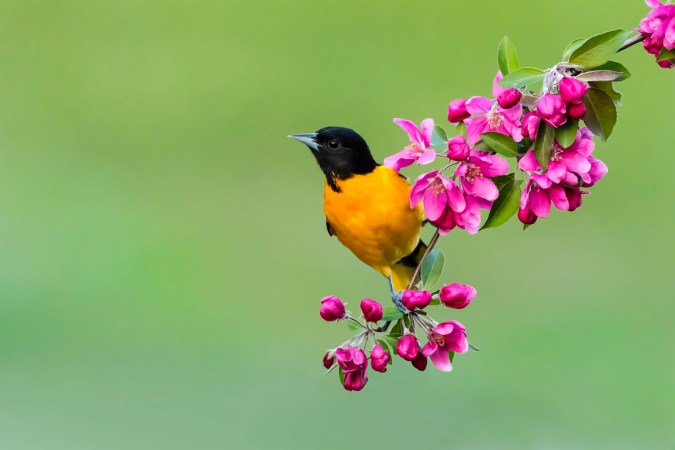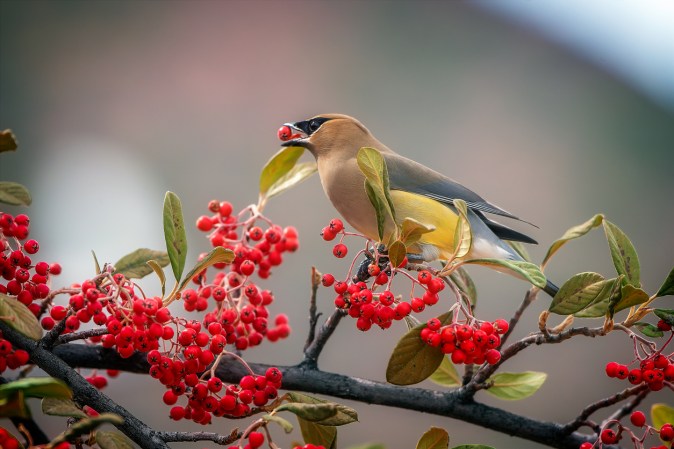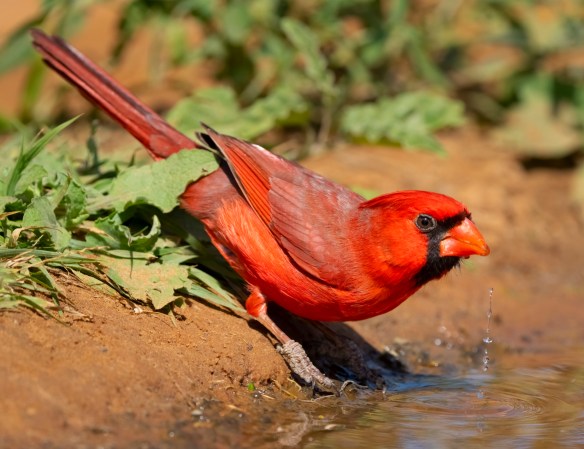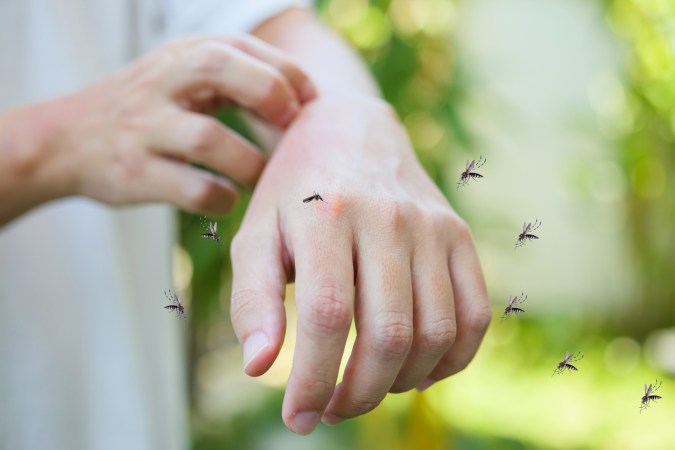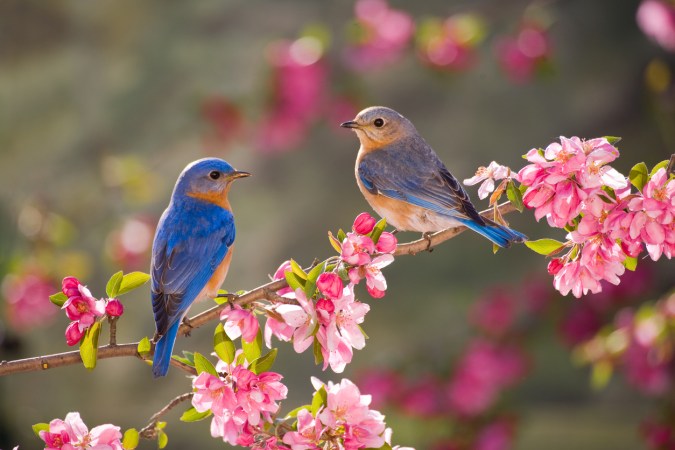We may earn revenue from the products available on this page and participate in affiliate programs. Learn More ›
Birds are important pollinators, but there are additional benefits of inviting them to your yard. Some backyard bird species are voracious bug eaters, which can help control populations of unwanted insects (such as mosquitoes, grubs, termites, ants, beetles, aphids, and spiders) around your home. Some small birds, such as finches and sparrows, eat a lot of weed seed—a benefit for gardeners. Larger wild birds, such as owls, kestrels, and hawks, hunt rodents, including unwelcome critters like mice, voles, and rats.
By providing a welcoming environment with food, shelter, and a water source, you can support and enjoy viewing many different birds in your own yard.
1. American Robin (Turdus migratorius)
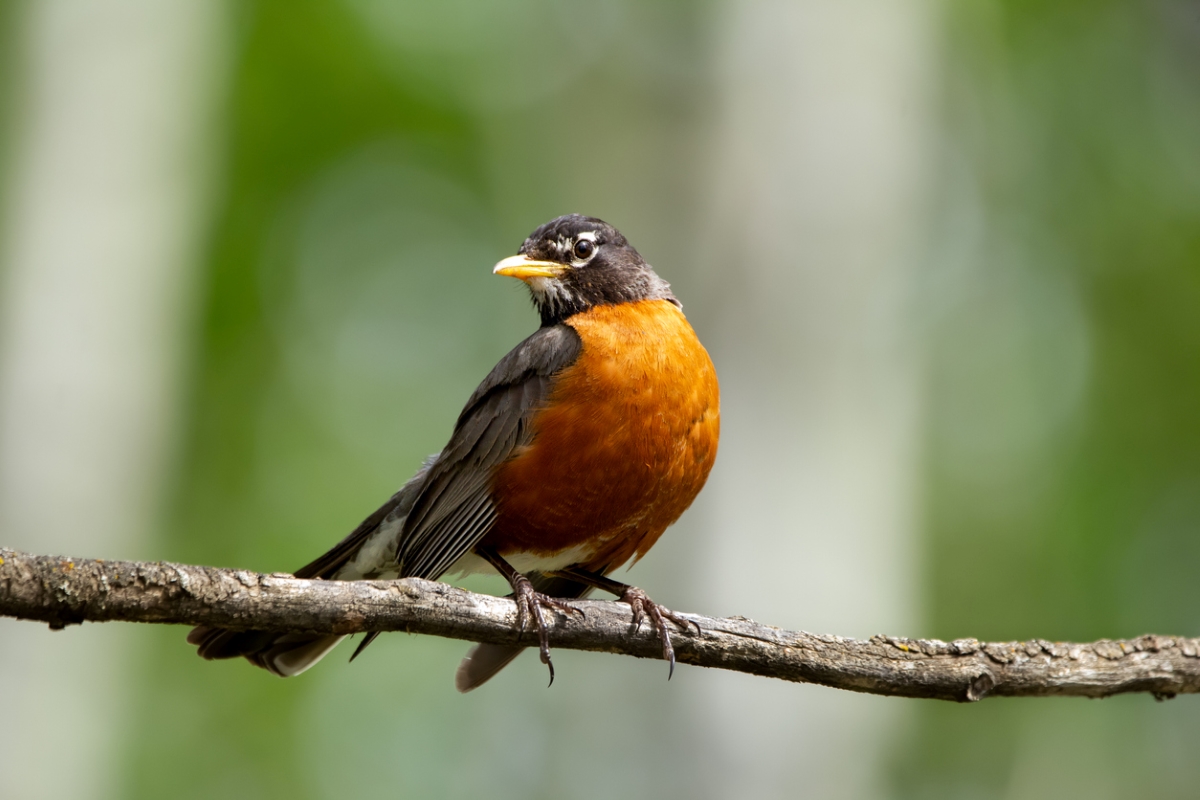
A sign of spring in most areas, the American robin is a welcome sight in many yards and gardens. These much-loved common birds are found in all of the lower 48 states, plus Alaska and Canada. They can produce up to three broods a year, and adults can live at least 6 years.
Easily identified by their orange bellies and dark-gray backs, American robins can be spotted on lawns foraging for worms and insects. They will visit platform feeders and particularly enjoy sunflower seeds, peanut hearts, mealworms, and fruit. Native plants that produce berries—such as juniper, hawthorn, sumac, and dogwood—also attract them.
Key Characteristics: Round orange bellies under dark-gray backs help identify American robins, as does their cheerful song.
Habitat Range: Found in every state but Hawaii, plus Canada, some robins winter down south and return in the spring, but many hang out closer to home, where they can satisfy winter diets.
RELATED: 9 Things You Can Do to Keep Birds Well Fed in Winter
2. Northern Cardinal (Cardinalis cardinalis)
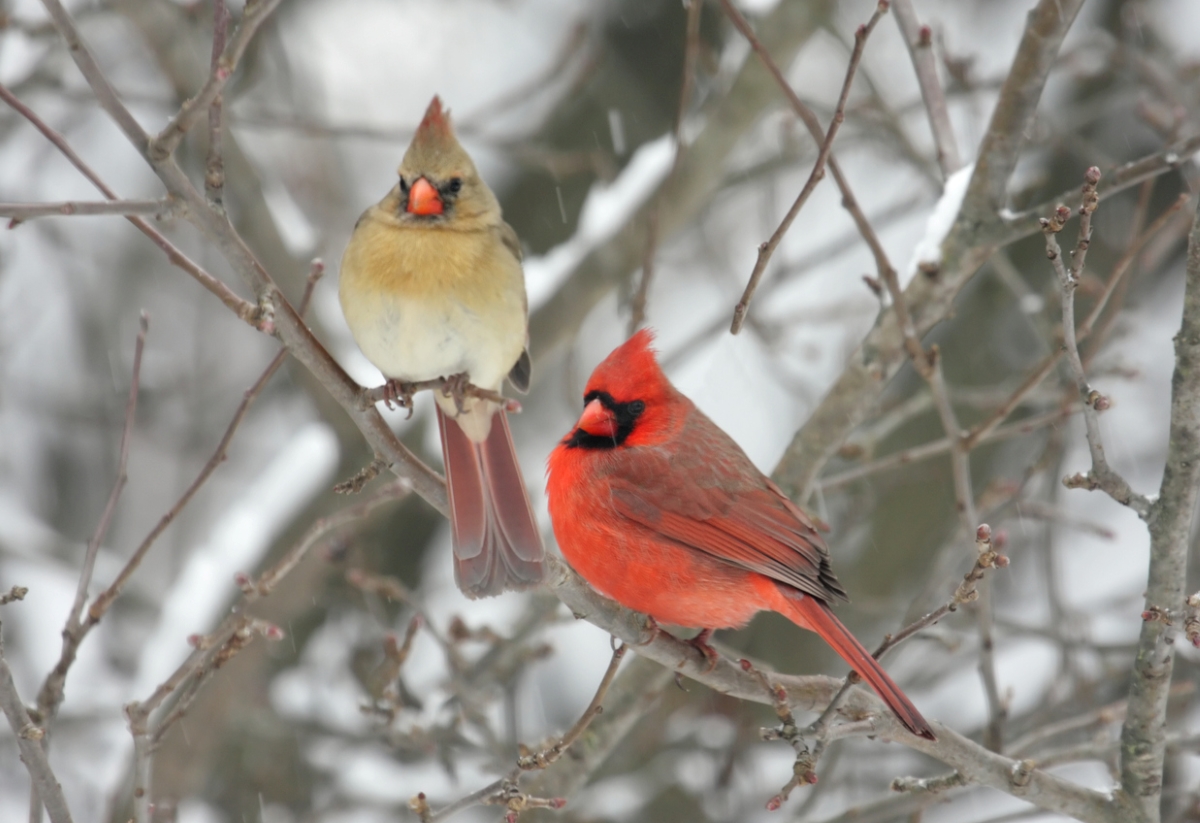
One of the most popular birds to spot is the Northern cardinal, which is quickly distinguishable by its pointed crest, bright crimson plumage, and black eye mask. Females are a soft gray-brown color with bright orange beaks and red highlights. They are often viewed in pairs in the eastern half of the country and throughout the south as far west as Arizona.
Their distinctive, high-pitched chirping and “what cheer” trilling calls indicate they’re nearby. Territorial and nonmigratory, cardinals will flock to your yard year-round if you supply black oil sunflower seeds, millet, peanut hearts, or milo.
Key Characteristics: Males are bright red with black eye masks, while females are a tawny brown with red highlights and orange beaks; both males and females feature a peaked crest.
Habitat Range: Northern cardinals are found in the eastern half of the U.S. and south as far west as Arizona.
3. Blue Jay (Cyanocitta cristata)
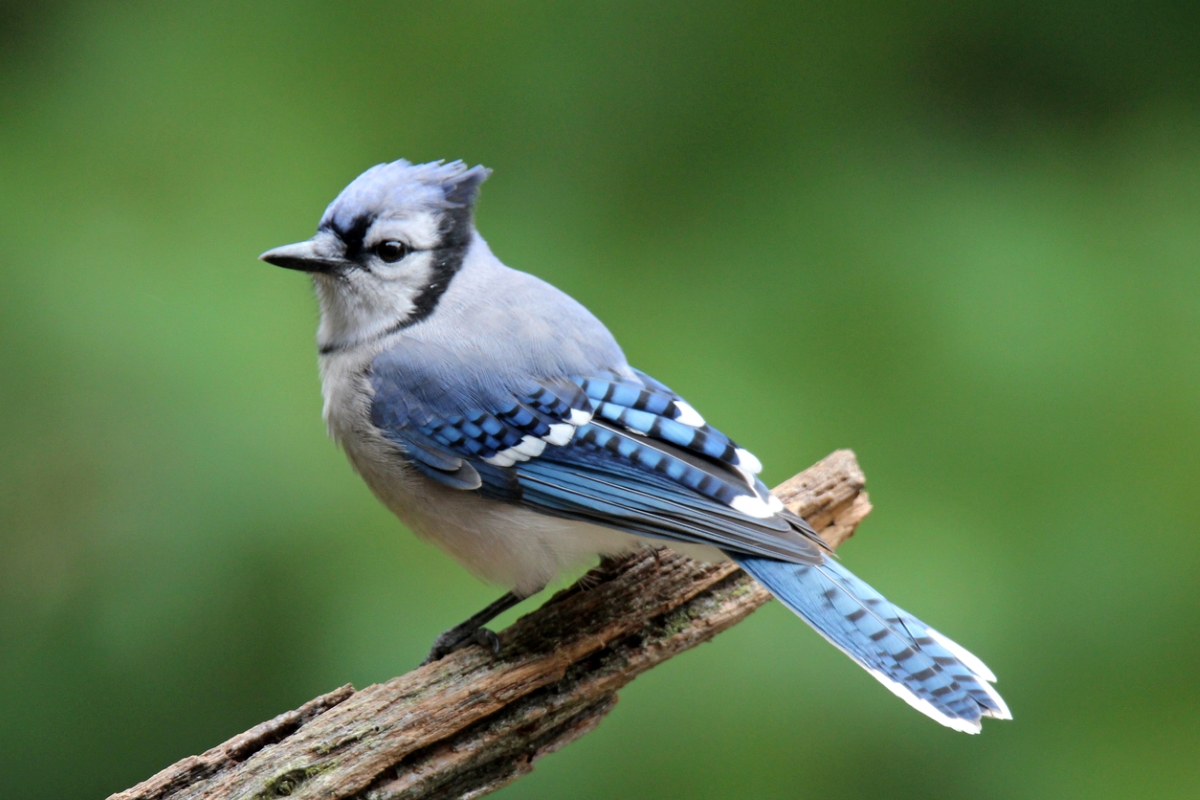
Another bird that’s as easily recognizable by its striking blue plumage as it is by its loud caw, the blue jay is one of the many birds native to America. This large, stunningly beautiful bird is intelligent, playful, and somewhat of a bully, often chasing other birds away from feeders.
Featuring an upright blue crest, blue-and-black back, and white underside, blue jays often travel in family groups from southern Canada to eastern and midwestern areas of the U.S. all the way to Texas and even Central America. They favor oak-filled forests, where they enjoy acorns, but they will also eat other nuts, grains, insects, and sunflower seeds.
Key Characteristics: Pointed crests of blue atop a blue-and-black back adorn this large, noisy bird.
Habitat Range: Blue jays range from southern Canada through the eastern and midwestern sections of the U.S. to Texas and even as far south as Central America.
4. House Sparrow (Passer domesticus)
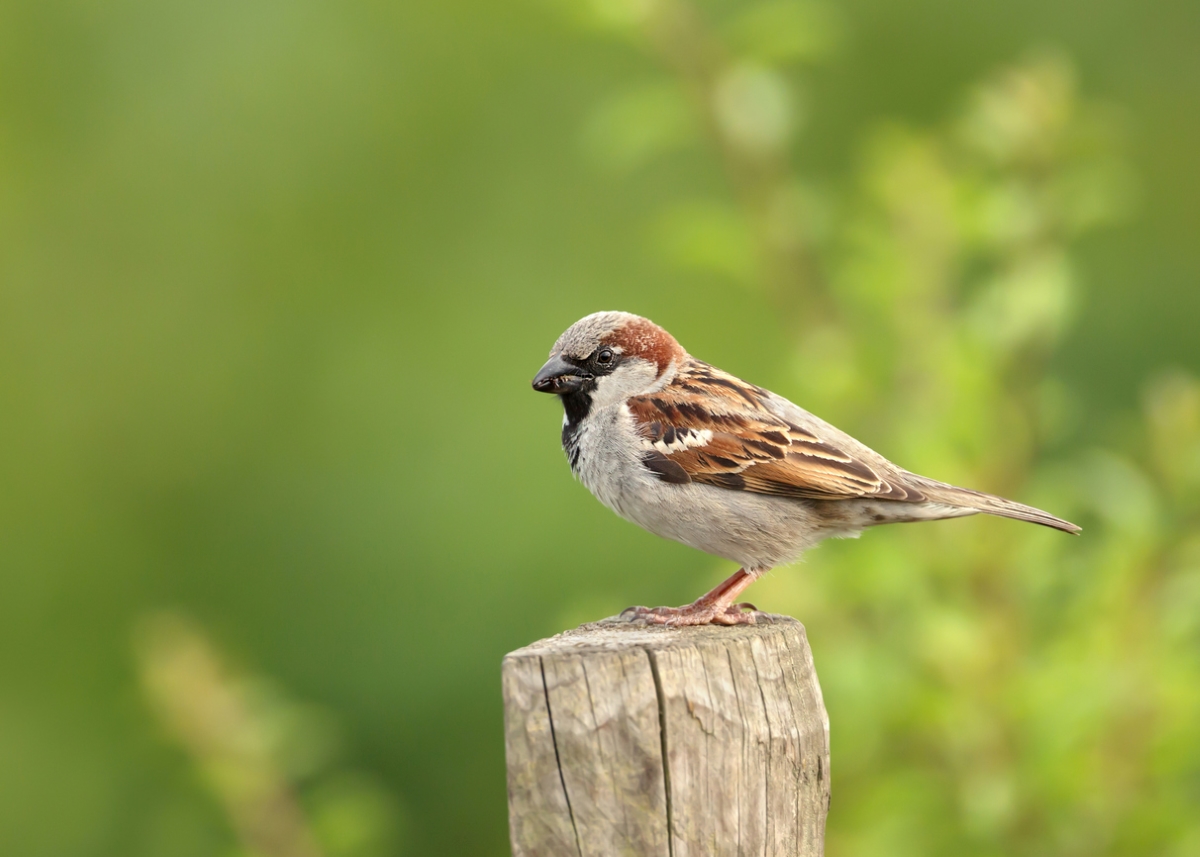
One of the most common types of birds is the house sparrow. An introduced species, sparrows thrive in human environments and have become relatively tame—sometimes eating out of people’s hands. While they prefer to eat seeds and grains such as sunflower seeds, millet, corn, and assorted birdseed from appropriately placed backyard feeders, they have been known to scavenge scraps of discarded food.
The house sparrow is nondescript, with a gray-brown head, black-and-brown back, gray chest and belly, and white cheeks. Sparrows live in groups led by the male with the biggest black patch.
Key Characteristics: A small gray-and-brown bird, the house sparrow is accustomed to humans, and the birds often hang around houses and buildings.
Habitat Range: House sparrows are found in the lower 48 states and southern Canada year-round.
5. American Goldfinch (Spinus tristis)
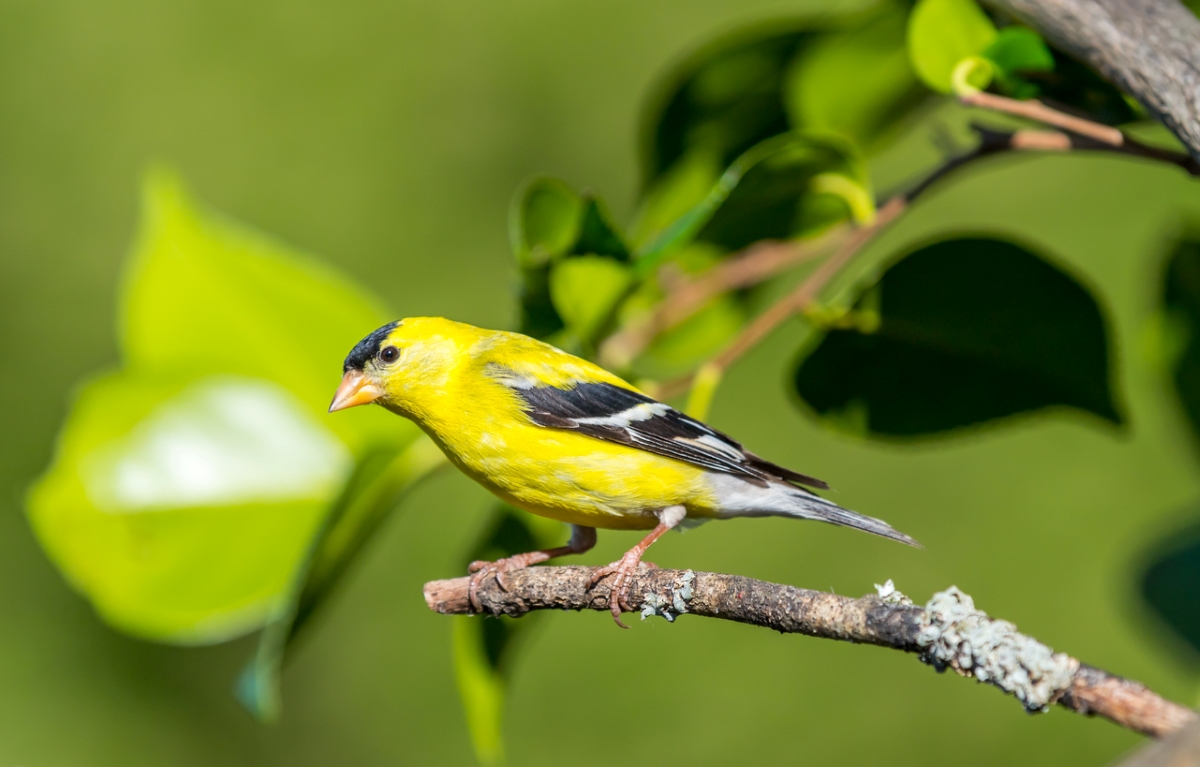
Among the colorful types of small birds that are easy to spot is the American goldfinch. Males feature a black cap above their golden feathers that turns an olive color during the winter and matches the appearance of the females. Both genders have white wing bars.
Goldfinches haunt overgrown, weedy fields in search of flowers and seeds. They like a bird garden filled with sunflowers, marigolds, dahlias, dandelions, zinnias, chicory, yarrow, chamomile, asters, ragweed, coneflowers, mums, and milkweed. While it’s actually carotenoid-rich seeds that give them their bright yellow coloring, they are most often associated with nyjer (thistle), and will frequent tube feeders filled with the tiny seeds.
Key Characteristics: These small birds have a big yellow color.
Habitat Range: Goldfinches are seen in most of the U.S., with some breeding in Canada and the Midwest; they are irregular in migration habits depending on food supply.
6. Black-capped Chickadee (Poecile atricapillus)
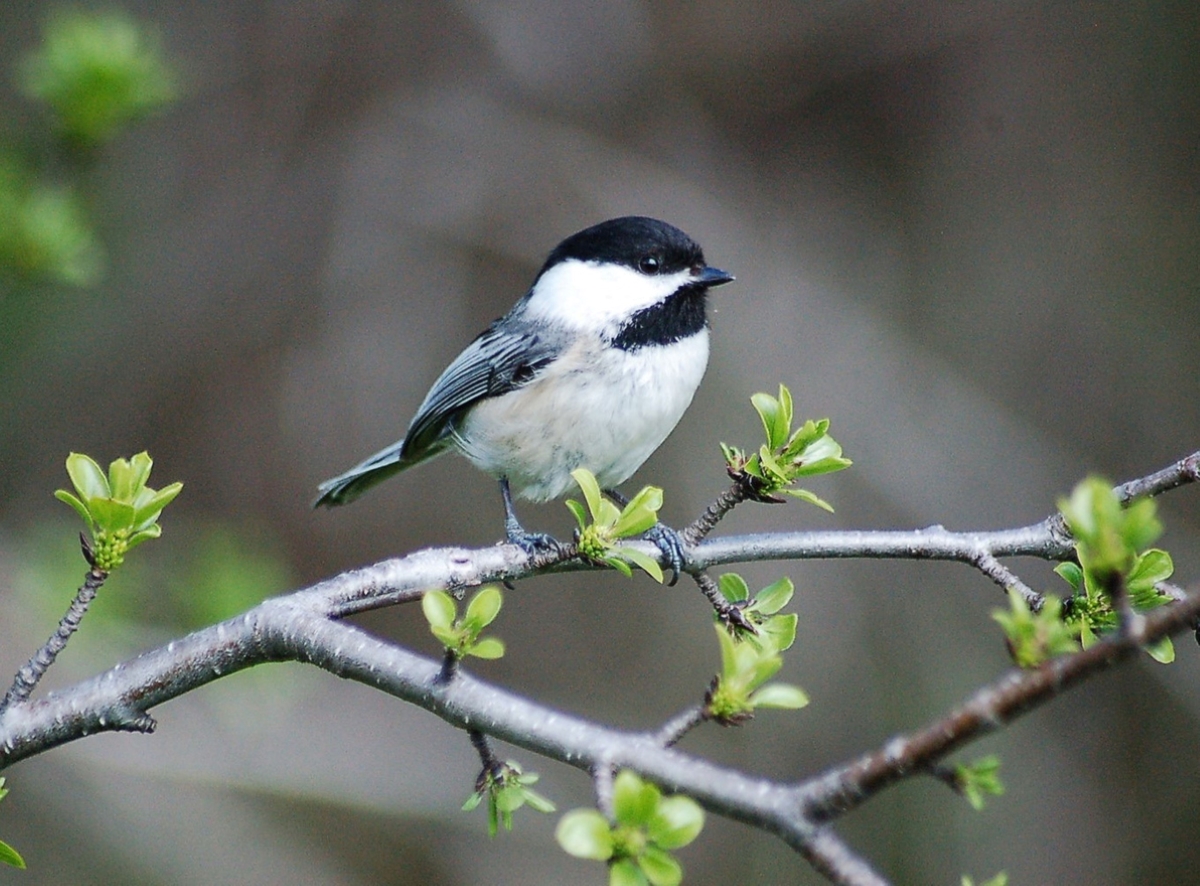
One of the friendliest American birds, the black-capped chickadee might just be tempted to eat from your hand. These small northeast birds can be identified by the white cheeks peeking out from between a black cap and chin. Another way to recognize these little birds is by their distinctive “chickadee-dee-dee” call.
Often seen on the edge of forests, open woods, and even parks, energetic chickadees will explore everything in their environment, including new feeders. Preferred feed includes seeds, berries, suet, insects, and spiders. They appreciate nest boxes filled with wood shavings.
Key Characteristics: Small birds with a big round head featuring a black cap and white cheeks, black-capped chickadees have tiny bodies.
Habitat Range: These nonmigratory birds are found in the northern U.S. and the Appalachian region.
7. Mourning Dove (Zenaida macroura)
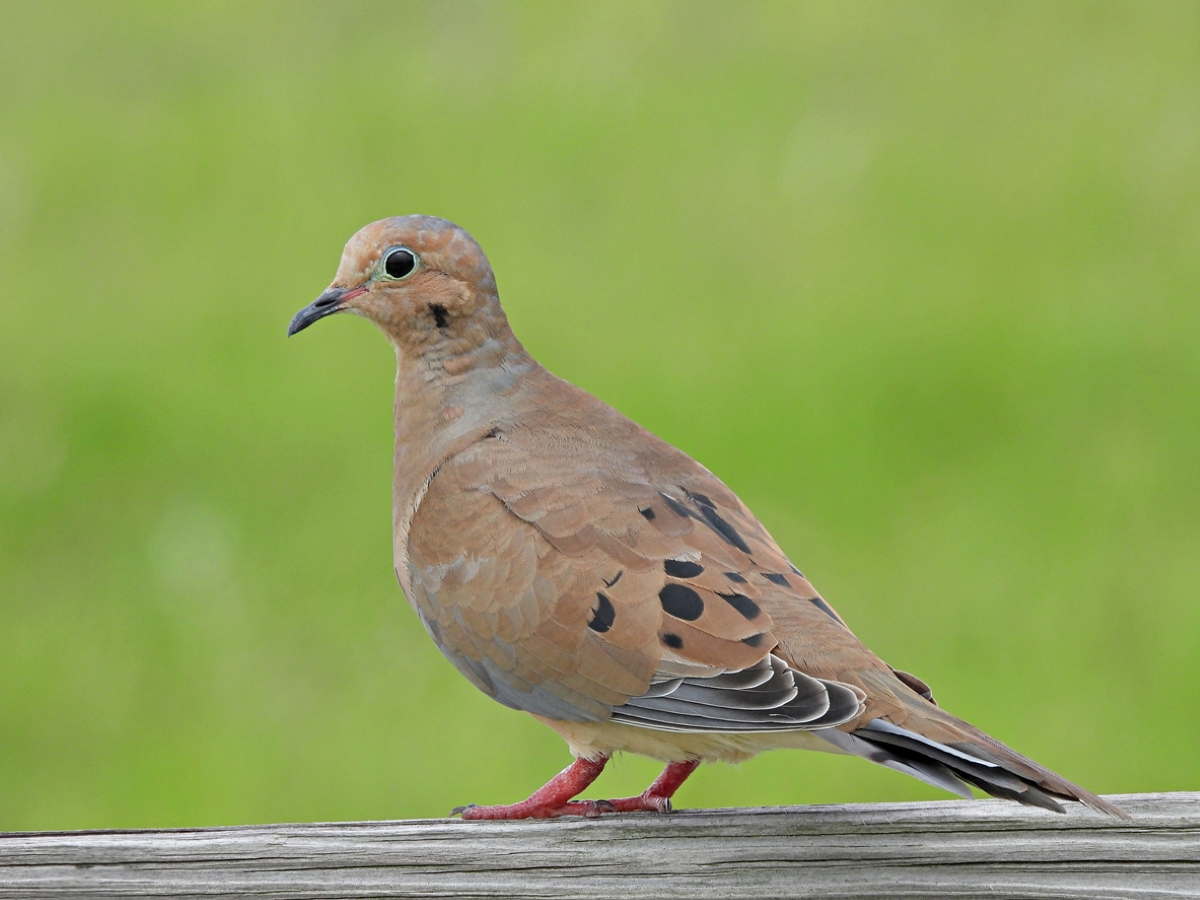
Often seen perched on power lines, mourning doves are graceful birds with small heads, a light- blue eye ring, and plump bodies uniformly colored brown-gray and ending in a long, pointed tail. Slightly reminiscent of its cousin the pigeon, the mourning dove’s melancholy cooing is sometimes confused with the hooting of an owl, but the whistling sound made by its wings when it flies belies that mistaken identity.
An easily startled ground feeder, the mourning dove forages for sunflower seeds, nyjer, cracked corn, millet, and peanut hearts in fields, backyards, and fields.
Key Characteristics: Characterized by small heads, plump bodies, graceful lines, and black spots on their soft-brown wings, mourning doves are known for their cooing.
Habitat Range: The most common dove in the U.S., this bird is found throughout the lower 48 states and southern Canada all year; some of these Midwest birds may migrate after breeding.
8. Ruby-throated Hummingbird (Archilochus colubris)
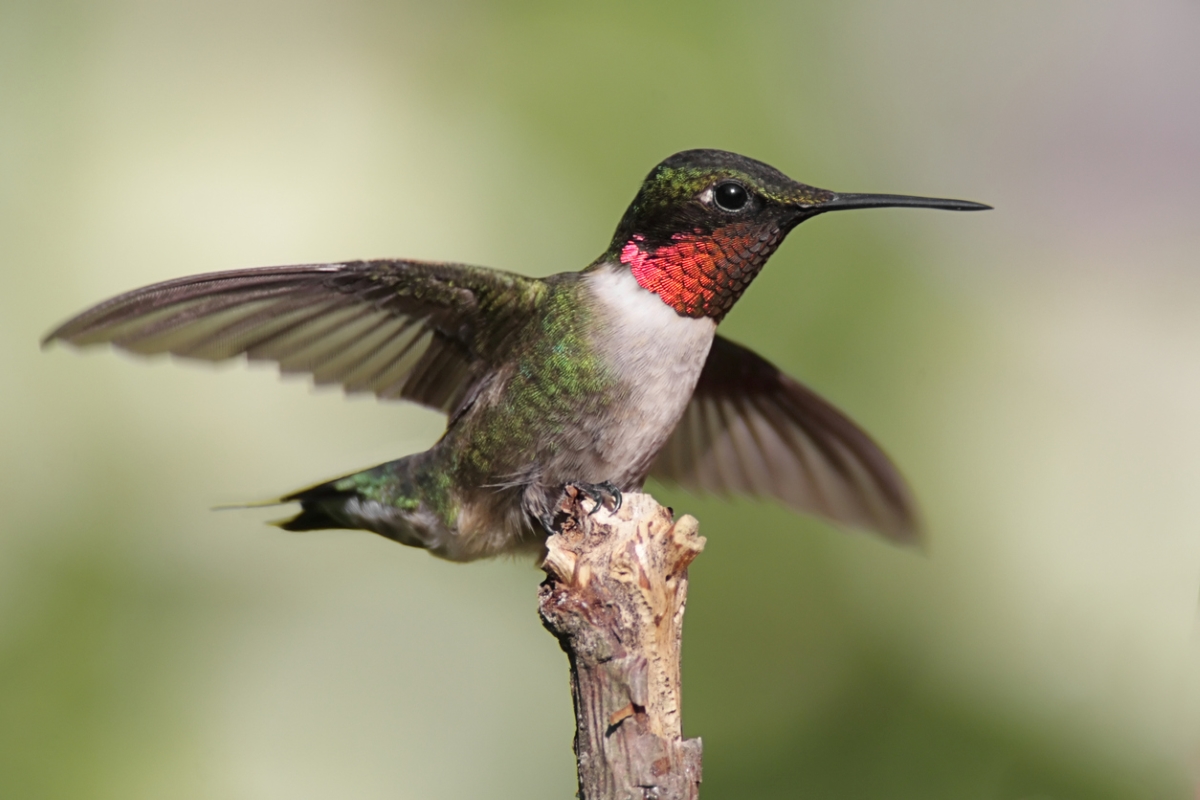
The fascination with these tiny backyard birds who hover at specialized feeders and flowers never wanes. Ruby-throated hummingbirds delight us as much with the shimmering, iridescent green color on their backs and crowns as they do with their buzzing, rapid wing movement that allows them to sip nectar mid-flight. Males also have red throats, while females have brownish crowns and sides.
Because ruby-throated hummingbirds are the only breeding hummingbird in eastern North America, many people like to support them by planting nectar-producing flowers and hanging sugar-water feeders for their short stays from February to August, depending on the region.
Key Characteristics: These birds are known for the iridescent bright green on their backs and the males’ ruby red–colored throats.
Habitat Range: Ruby-throated hummingbirds spend part of the year in eastern North America, migrating through Texas and the Gulf to Central America for the winter.
9. Downy Woodpecker (Dryobates pubescens)
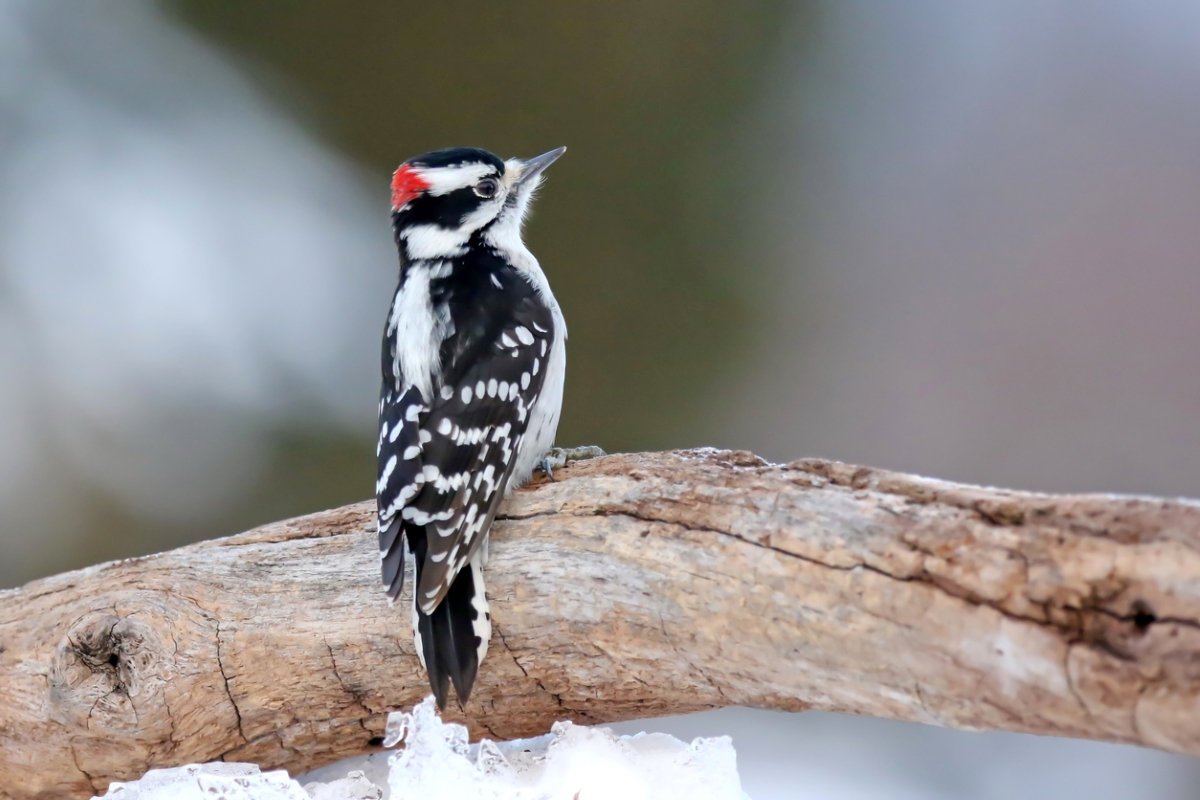
The distinctive tap-tap-tapping of the downy woodpecker gives it away, but its striking black-and-white plumage with the small red patch on its head makes it stand out in the landscape. It looks like, but is smaller than, the hairy woodpecker and has a shorter beak.
This nonmigratory woodpecker, which is the smallest and most abundant of woodpeckers, can be seen along streams and in backyards and parks, where the birds search for insects and beetle larvae, as well as acorns, berries, and grains. A platform feeder offering black oil sunflower seeds, millet, and peanuts, or a suet feeder, will draw them to your yard.
Key Characteristics: The smallest woodpecker, the downy woodpecker is black and white with a small red patch on its head.
Habitat Range: Downy woodpeckers are found throughout most of the U.S. (except the arid southwest) and much of Canada (except northern regions).
10. Eastern Bluebird (Sialia sialis)
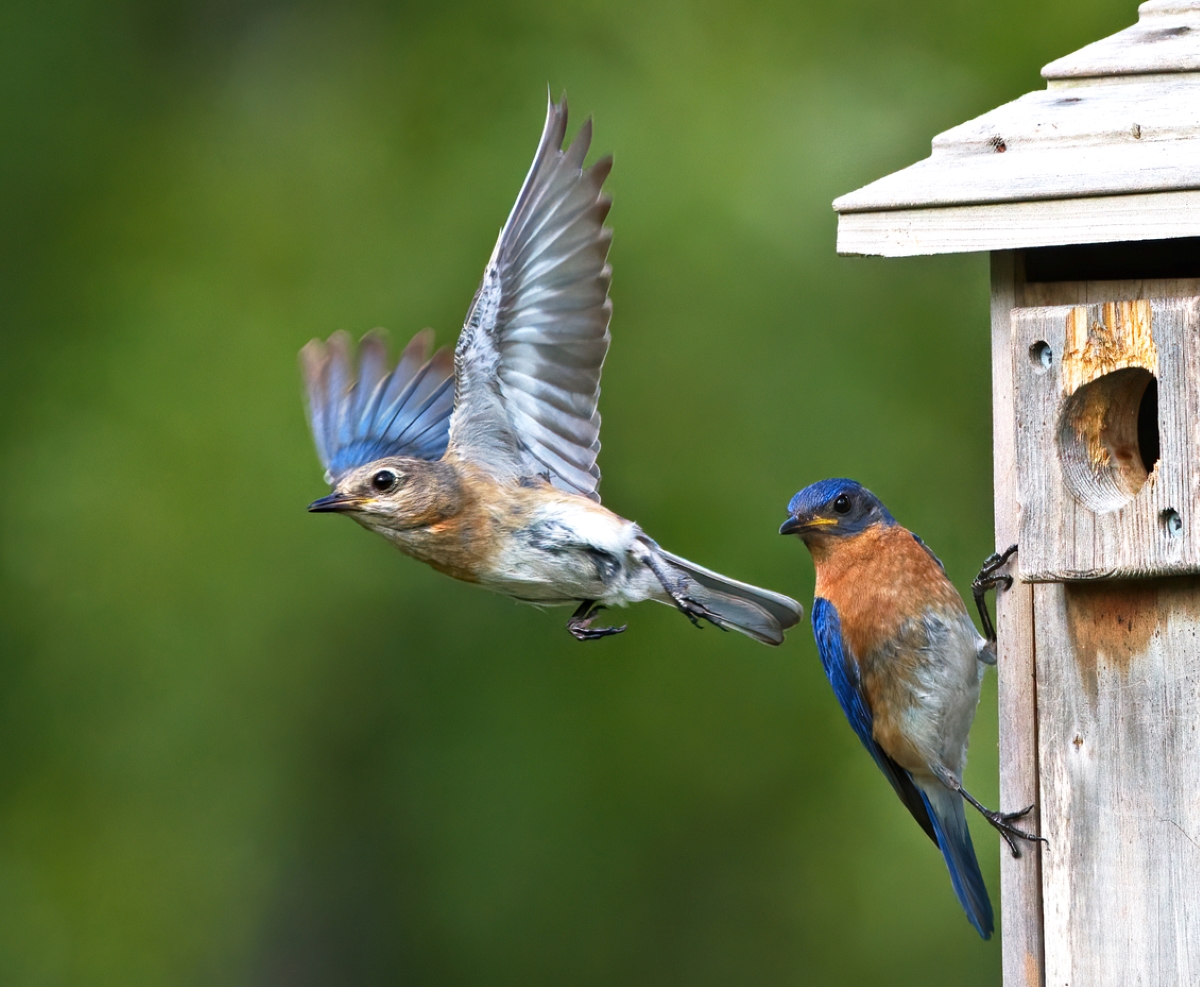
Long considered a symbol of happiness in many cultures, the eastern bluebird is a pretty bird that has a large, rounded head; big eyes; and a big belly. Males have deep-blue feathers on their backs with a reddish color underneath. Females are grayer but have blue in their wings and tails and an orange-brown breast.
Because these songbirds (who are small thrushes) don’t eat a lot of seeds, the way to attract them is by providing mealworms in special feeders, planting native berry bushes, or providing safe water and nesting boxes or bluebird houses.
Key Characteristics: Eastern bluebirds are round birds with blue plumage and big, dark eyes.
Habitat Range: As the name implies, the eastern bluebird is found primarily in the eastern and southeastern portions of the country.
RELATED: The Best Squirrel-Proof Bird Feeders Tested by Bob Vila Experts
11. Baltimore Oriole (Icterus galbula)
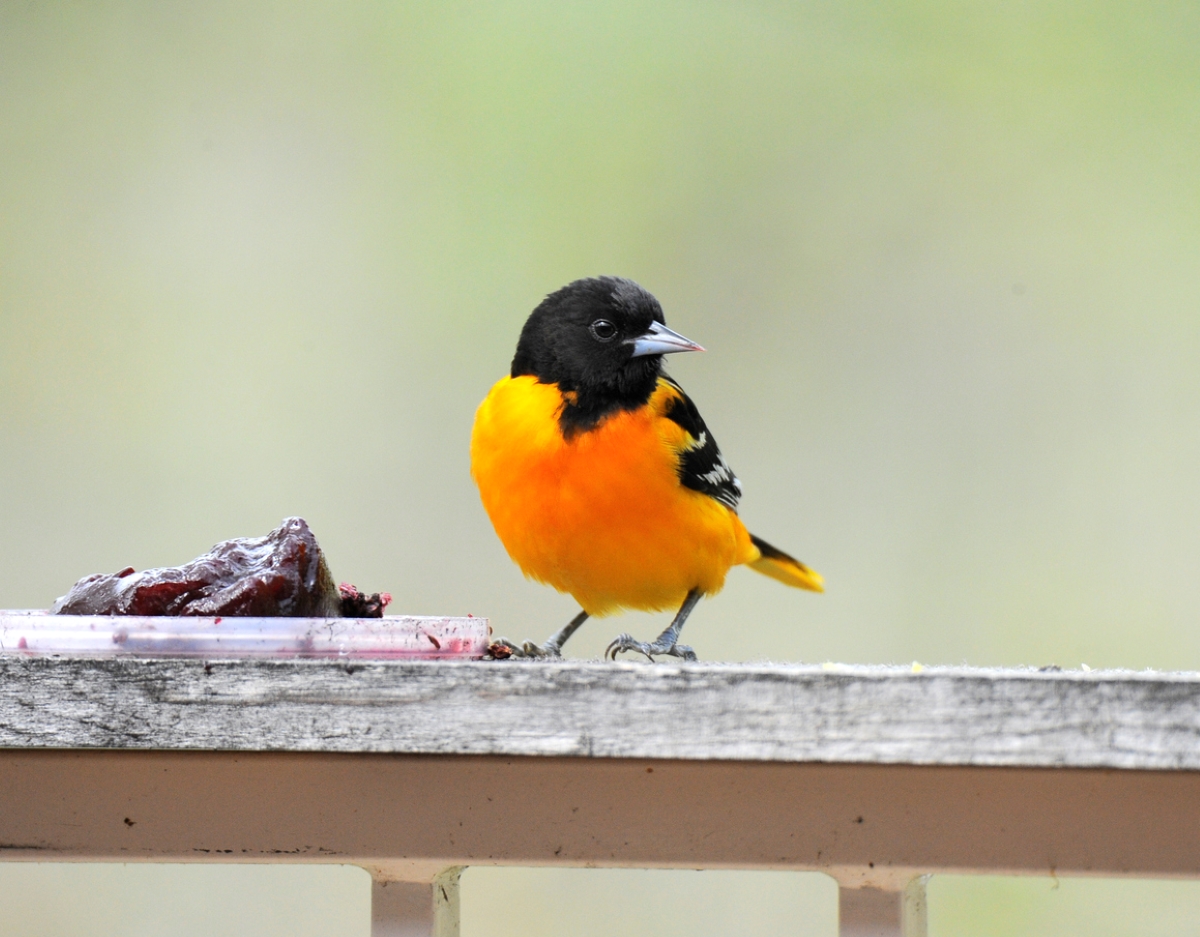
A medium-size member of the blackbird family with a thick neck; long legs; and a thick, pointed bill, the Baltimore oriole is best known for its black-and-orange Halloween colors. Males feature a black hood, back, and throat along with orange underparts and rump. Its wings also feature some orange and always have white bars. Females have softer coloring with yellow instead of orange and a lighter hood.
Orioles are known for having a “sweet tooth.” They enjoy fruit, which they eat in an unusual way called “gaping,” inserting their beaks into food, spreading their beaks and letting their tongues lap up the juices. They also eat sugar water, flowers, and even grape jelly.
Key Characteristics: The Baltimore oriole’s most distinguishing characteristics are its bold orange color; pure, whistling song; and love of sweets.
Habitat Range: Found in the eastern two-thirds of North America from the Canadian prairies to Mississippi and throughout the eastern U.S., Baltimore orioles winter in Mexico, the Caribbean, and South America.
12. Black-billed Magpie (Pica hudsonia)
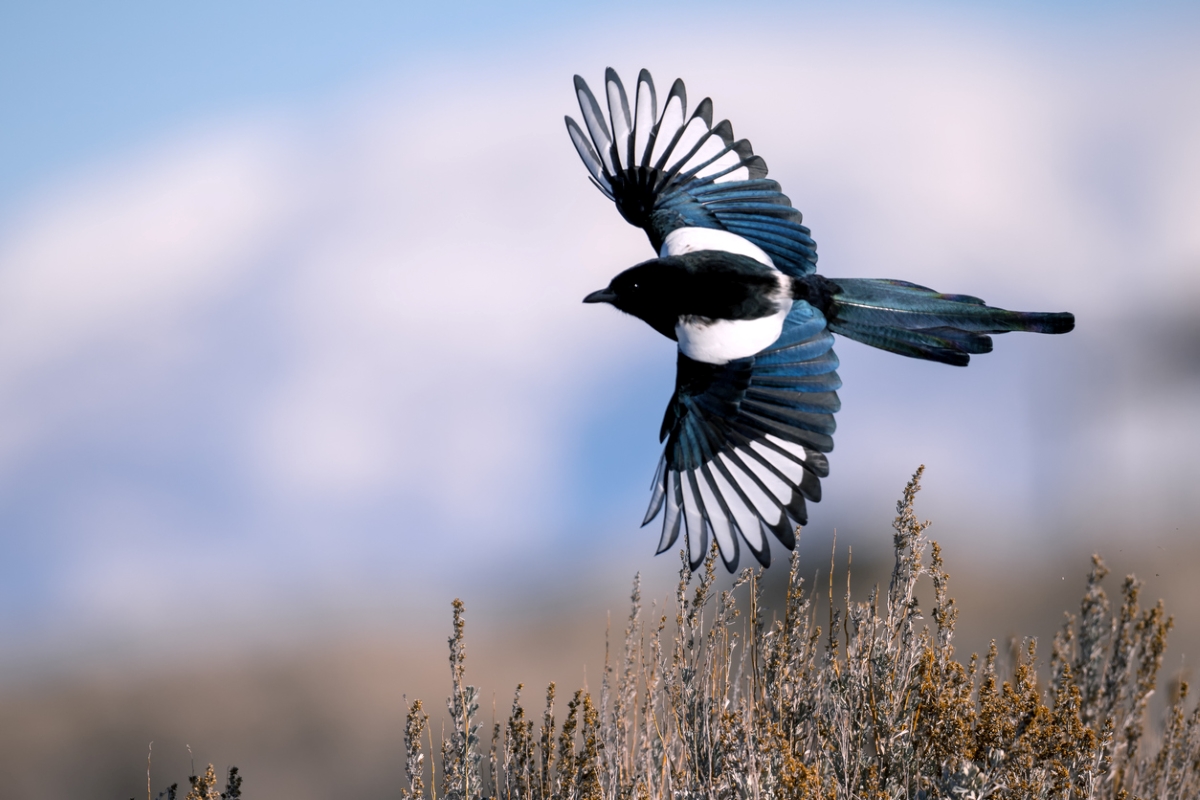
Also called the American magpie, this corvid is a large bird with a long, diamond-shaped tail and striking black-and-white coloring highlighted by blue-green iridescence in its wings and tail. Two white “backpack strap” stripes line the outer wings on the back.
Social, inquisitive birds, black-billed magpies live in groups, and they flap steadily during flight. They communicate with a combination of trills, cackles, and whistles. These foragers aren’t fussy eaters, consuming everything from grasshoppers, beetles, and other insects to small rodents, carrion, fruits, and grains. They congregate in feedlots, fields, streams, and towns—wherever food is easy to come by.
Key Characteristics: A large bird with distinctive black-and-white coloring, the magpie struts around open areas as it forages for food.
Habitat Range: Black-billed magpies live in the western half of North America, from southern coastal Alaska to northern California, Nevada, Arizona, New Mexico, and central Kansas and Nebraska.
13. Dark-eyed Junco (Junco hyemalis)
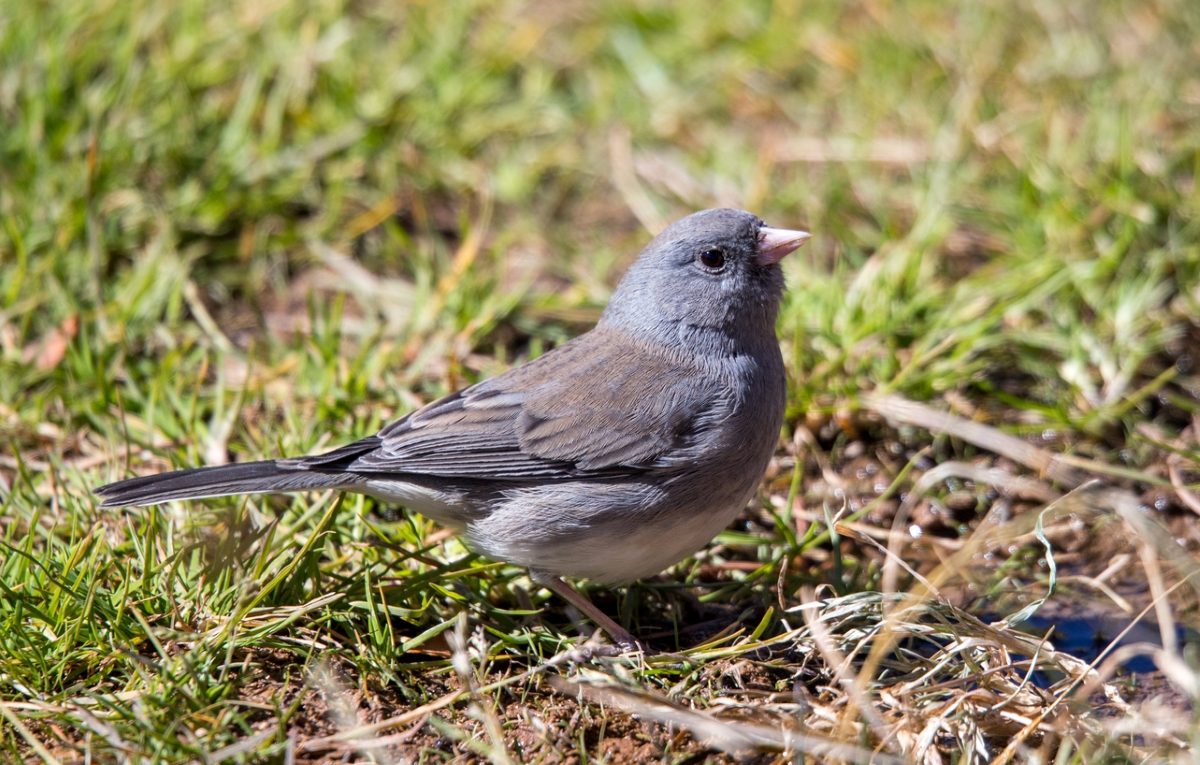
Flashy little sparrows that are sometimes referred to as snow birds because they seem to appear when temperatures fall, the dark-eyed junco is a small bird, typically grayish in color with a white belly and tail (although coloring varies in Western regions).
Their summer diet consists primarily of berries and insects—caterpillars, grasshoppers, beetles, and spiders. In the winter, they eat weed seed and grass seed, which is why they’re primarily seen foraging on the ground. They’ll visit backyard feeders stocked with black oil sunflower seeds, nyjer, millet, cracked corn, and peanuts—especially if it’s scattered on the ground or placed on a platform feeder.
Key Characteristics: Dark-eyed juncos are small sparrows with predominantly slate-gray coloring and white undersides, and they are often found foraging on the ground.
Habitat Range: They can be found in the Northeast, West, and Appalachian Mountains all year. Some breed in Alaska and Canada, with migration to most parts of the U.S. occurring in winter months.
14. American Crow (Corvus brachyrhynchos)
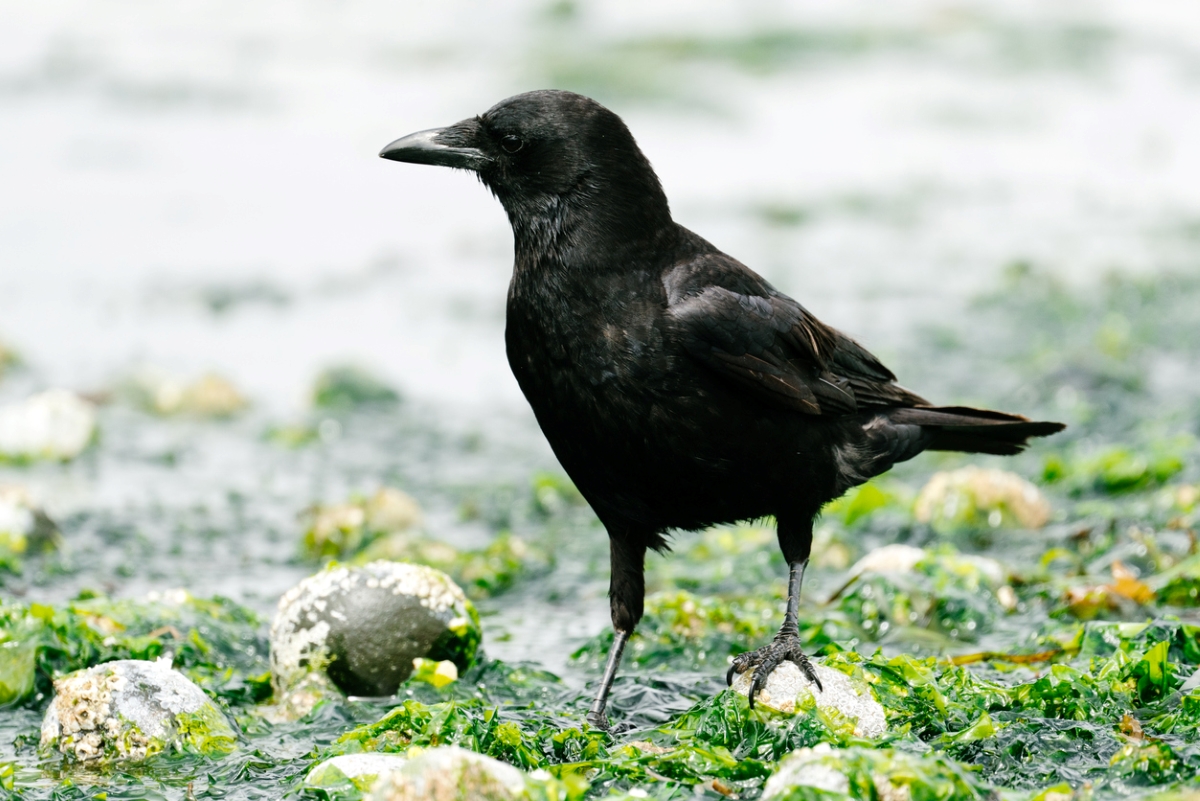
As a member of the corvid family, the American crow is highly intelligent and curious, and these birds are capable of problem-solving and using tools. These large, all-black birds make a sharp “caw” sound. In winter, they sometimes gather in groups of up to 2 million to sleep in communal roosts.
Found in woods, fields, beaches, and towns, American crows feed on the ground, selecting worms, insects, seeds, and fruit. They are also known to eat fish, mussels, clams, eggs, and nestlings of various bird species.
Key Characteristics: These big, shiny, all-black birds are often heard before they’re seen, with the famous “caw” sound giving away their identity.
Habitat Range: American crows are present in all of the lower 48 states, Alaska, and the Pacific Coast in Canada all year, but some that breed in Canada and the northern Midwest migrate south for the winter.
15. European Starling (Sturnus vulgaris)
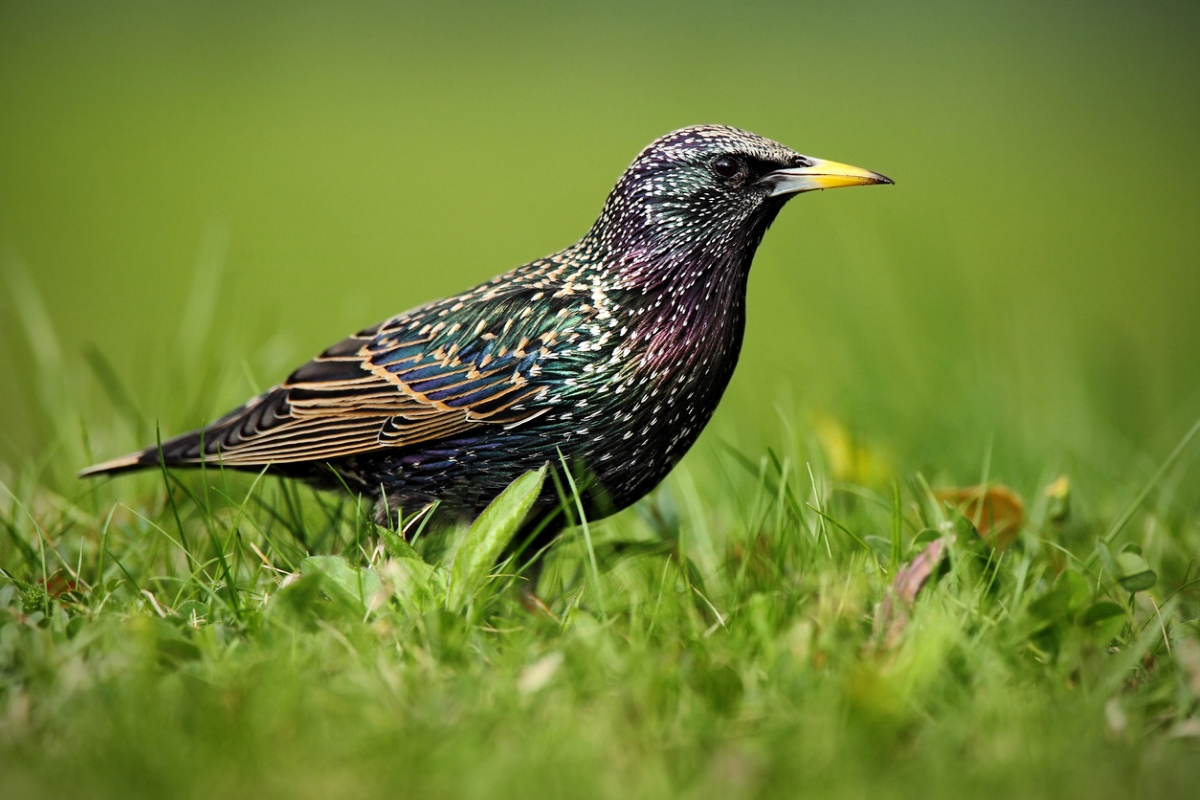
The omnipresent European starling is an introduced species many consider invasive. Stocky black birds with iridescent purple, blue, and green tones in summer and white spots in winter, they have short tails; triangular wings; and long, pointed beaks. They’re noisy, and they can mimic some other bird species.
These garden birds are known to travel in flocks and to be aggressive, chasing away native birds. They eat insects such as beetles, flies, caterpillars, earthworms, and spiders, and they root in lawns for grubs. These birds like fruit, holly berries, mulberries, blackberries, cherries, Virginia creeper, sumac, and grains and seeds. They’ll raid feeders stocked with black oil sunflower seeds, peanuts, cracked corn, or suet.
Key Characteristics: Medium-size and stocky, these noisy black birds have yellow beaks.
Habitat Range: European starlings have expanded their territory to all of North America except northern Canada and Alaska.
16. Red-winged Blackbird (Agelaius phoeniceus)
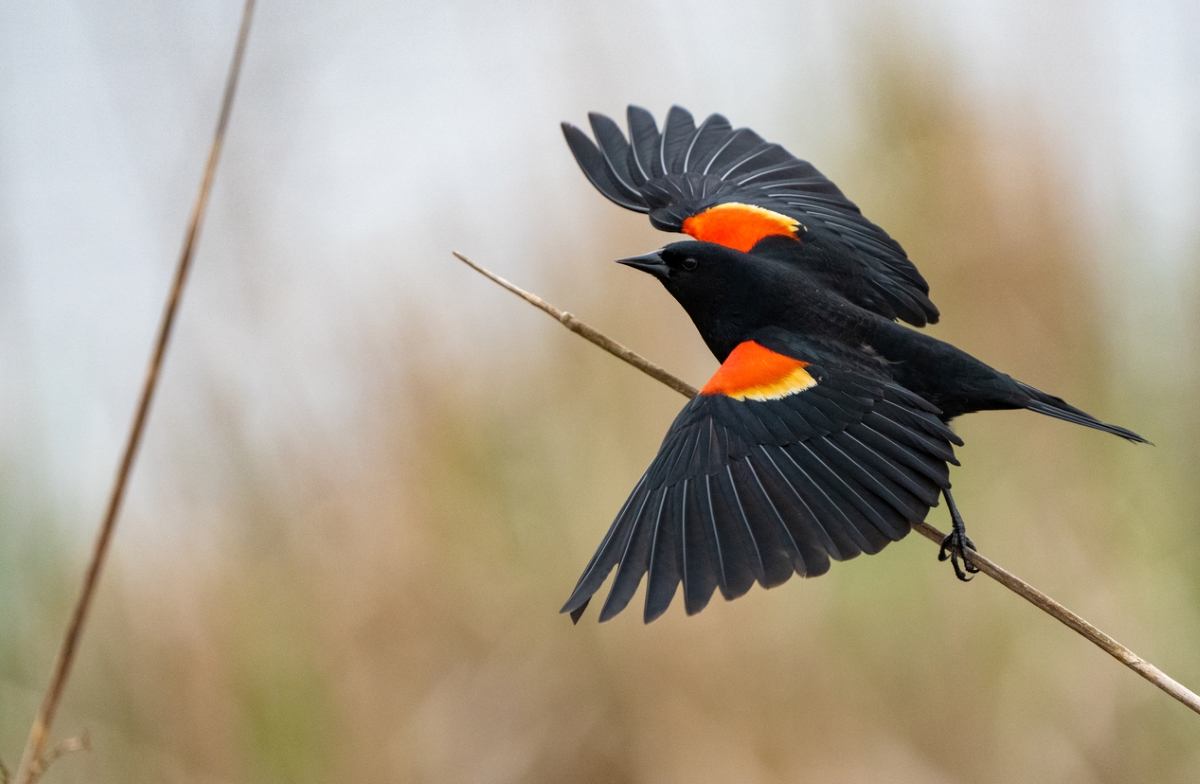
Often seen perched near farm fields, feedlots, pastures, and meadows, red-winged blackbirds are easily distinguishable by the red-and-yellow shoulder badges on their glossy black feathers. Females are dark brown with a paler breast and a whitish eyebrow. Both genders are stocky and broad-shouldered and have a slender, conical bill and medium-length tail.
The diet of this bird consists primarily of insects and seeds. Favorites include beetles, caterpillars, grasshoppers, and spiders. These birds eat grass seed, weed seed, and waste grain, and they also eat worms, fruit, berries, eggs, butterflies, frogs, and snails. Red-winged blackbirds visit platform feeders offering grains and seeds.
Key Characteristics: The distinctive red-and-yellow badges on the red-winged blackbird’s shoulders stand out against its glossy black feathers.
Habitat Range: Year-round in the lower 48 states and the Pacific Coast of British Columbia, with some who breed in Canada migrating south for the winter.
17. House Finch (Haemorhous mexicanus)
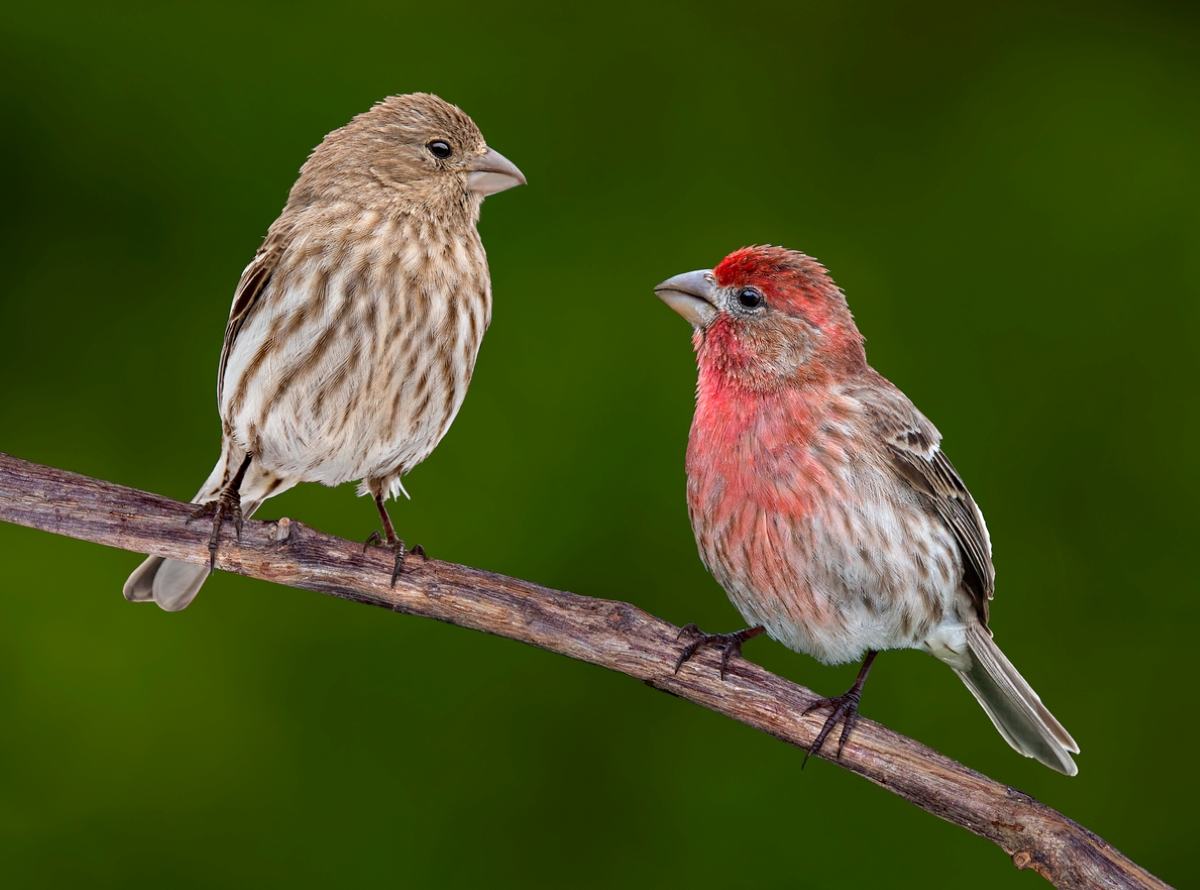
One of the most-seen visitors to bird feeders is the little house finch. Males have a red breast, head, and rump. Females are all brown with light striping on their breasts. In addition to frequenting bird feeders, they can be found in parks, at farms, and on forest edges—often in noisy groups.
House finches like fruits and vegetables, small flowers, insects, and seeds with a high oil content. They’ve even been known to partake of the sugar water in hummingbird feeders. Platform or tube feeders filled with black oil sunflower seeds or nyjer seeds will attract them.
Key Characteristics: Small birds with red heads and chests, they are prolific “talkers” and have a cheery chirp.
Habitat Range: Originally a Western U.S. bird, the house finch was introduced to the eastern part of the country and lives throughout North America.
18. Carolina Wren (Thryothorus ludovicianus)
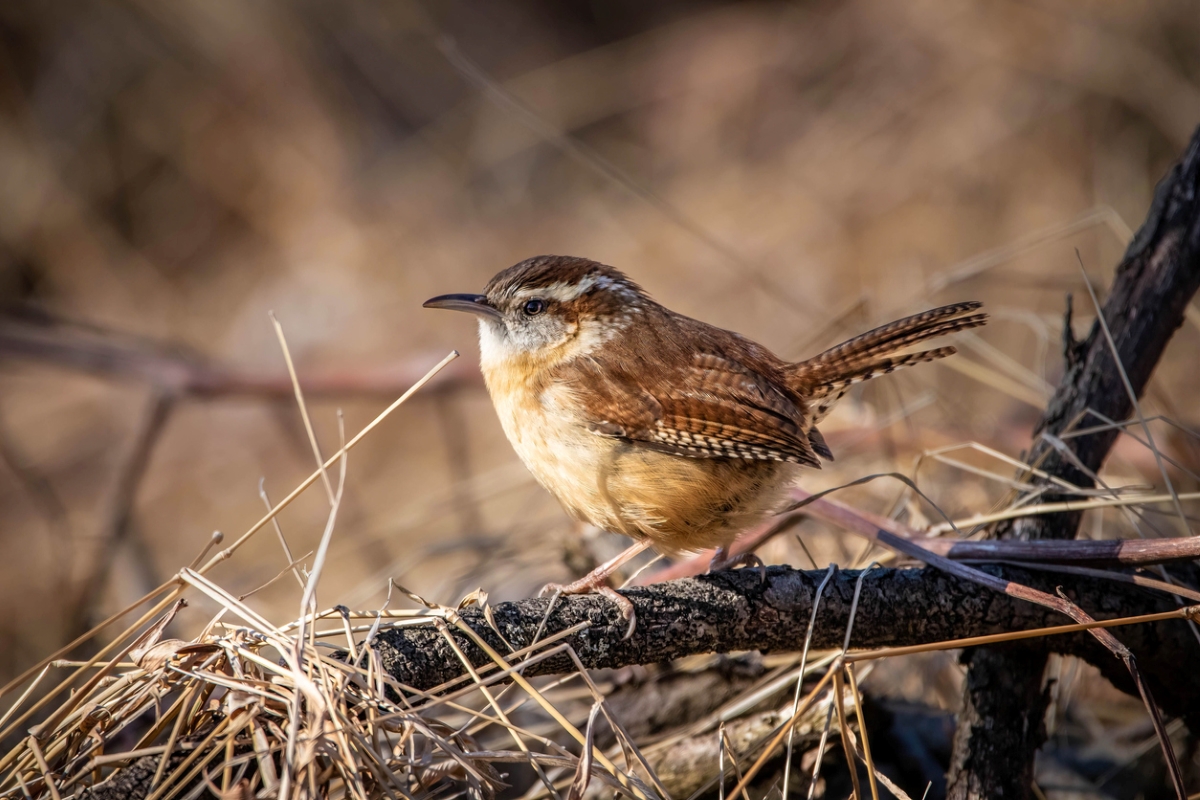
Carolina wrens, the most common wrens in the U.S., are more brightly colored than most wrens. They feature reddish-brown upperparts and buff-colored underparts, with dark-brown barring on wings and tail and a long white eyebrow stripe. These small birds sing a repeated, whistled note: “tea kettle, tea kettle, tea kettle.”
Found in open woods and thickly vegetated areas in urban settings, Carolina wrens explore brush piles and low tangles in backyards. Their diet consists mostly of insects—caterpillars, beetles, grasshoppers, crickets, and spiders—as well as small lizards, tree frogs, berries, and small fruit. They’ll visit backyard feeders offering hulled sunflower seeds, suet, or peanut hearts.
Key Characteristics: Small and shy brown birds, Carolina wrens are marked by a long white eyebrow stripe.
Habitat Range: These nonmigratory birds are found across eastern and southeastern states all year.
RELATED: 10 Outdoor Accessories Every Bird Lover Needs
19. Tufted Titmouse (Baeolophus bicolor)
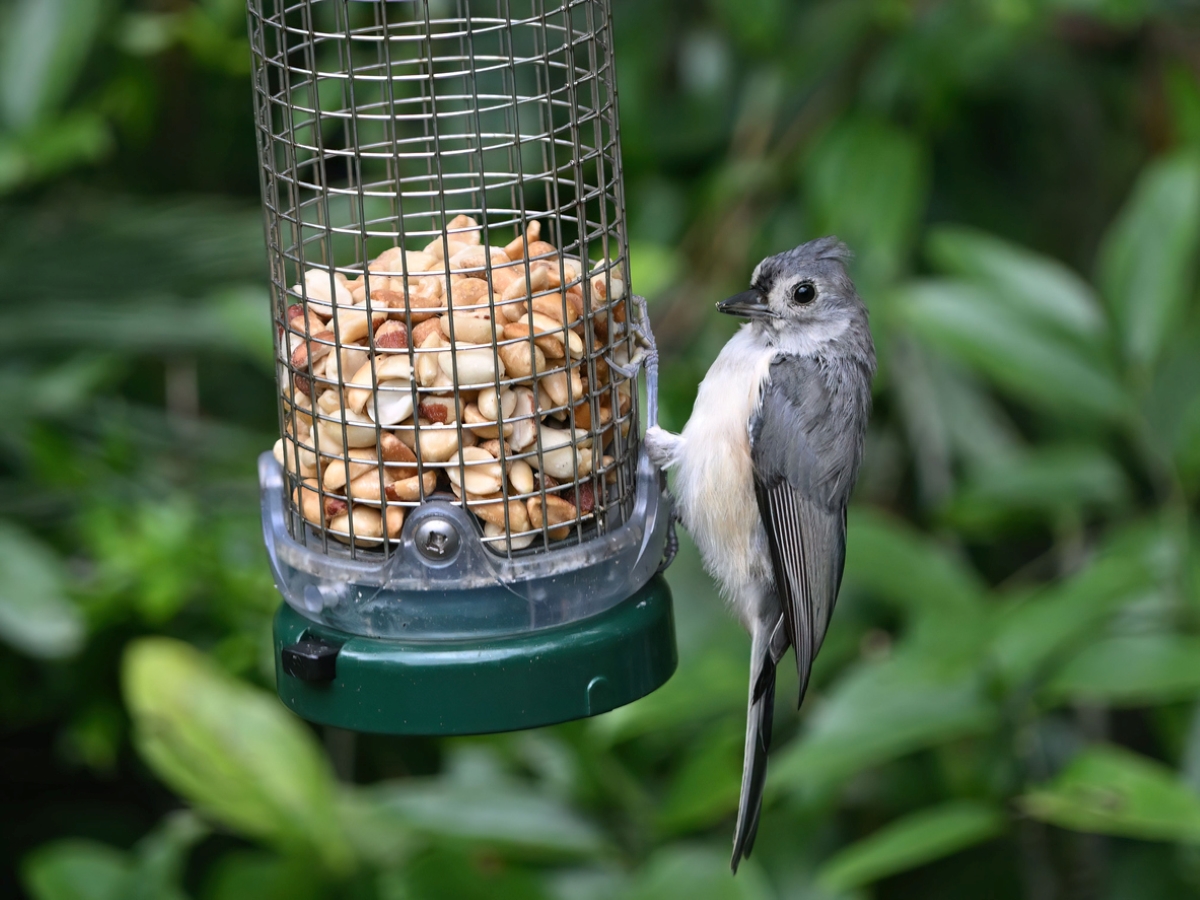
The tufted titmouse is a stocky, medium-size bird that sometimes flocks with chickadees, nuthatches, and woodpeckers. These birds are identified by a gray back; black forehead; white underparts with a peach wash on the sides; a gray crest; and large, dark eyes.
Tufted titmice can be assertive over smaller birds at the feeder, where they feast on sunflower seeds, suet, and peanuts in tube feeders, platform feeders, and suet cages. Food they forage for in parks and woodland areas includes caterpillars, beetles, ants, wasps, spiders, and other insects. They also eat seeds, nuts, and berries.
Key Characteristics: Immediately identifiable by the gray crest on its head, the tufted titmouse has a gray back and white underparts with a rust-colored wash on its sides.
Habitat Range: The tufted titmouse is found in the eastern and southeastern parts of the U.S.
20. Barn swallow (Hirundo rustica)
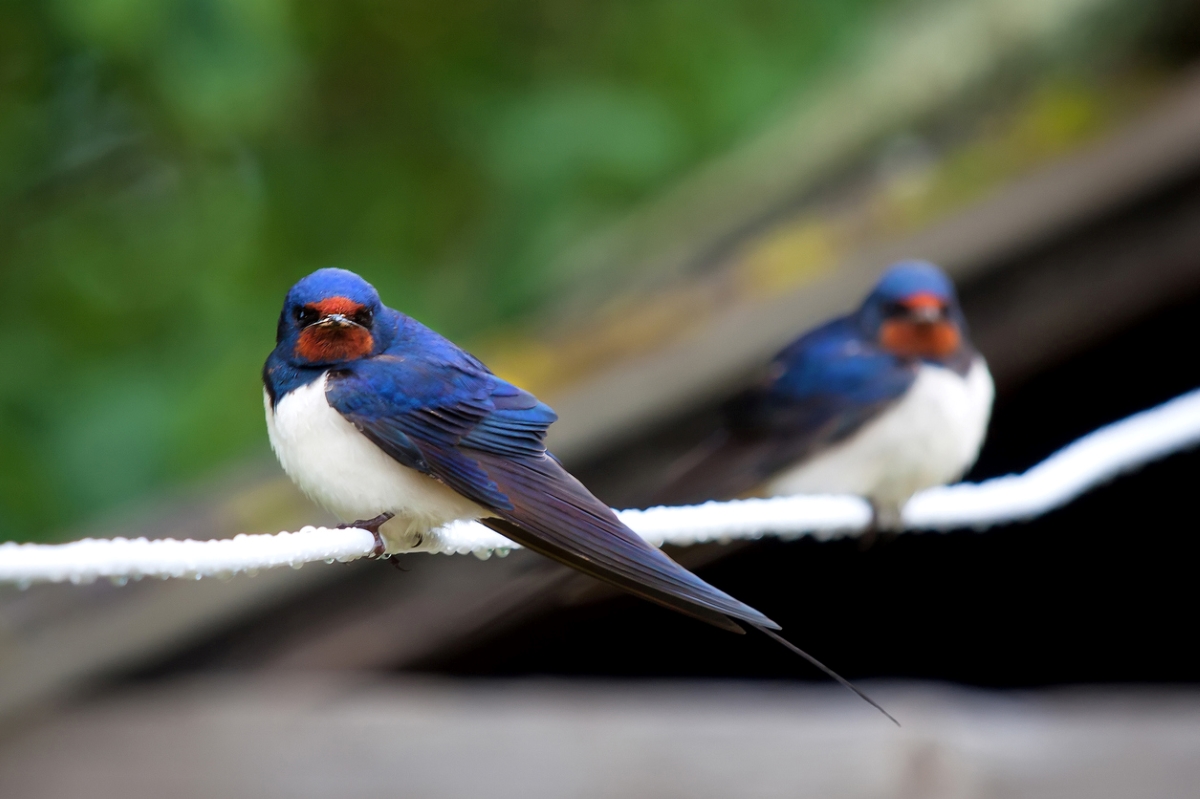
Most farmers and rural dwellers are familiar with the dive-bombing barn swallow. A small bird with a steely-blue back, wings, and tail; reddish underparts; a blue crown and face; and a cinnamon-colored forehead and throat, the barn swallow has a slightly flattened head, no visible neck, and broad shoulders. It has long, pointed wings and a tail that extends beyond the wingtips, giving the impression of a deep fork.
Found in open fields, parks, and roadway edges, barn swallows build cup nests of mud pellets almost exclusively on manmade structures. They feed on the wing, catching insects in flight, but they also eat aquatic insects.
Key Characteristics: Small birds of blue that are so dark they appear almost black, barn swallows swoop and dive through the air and have long wings and a tail that looks like a deep fork.
Habitat Range: Found in most of Canada (except the extreme north) to almost all of Florida and into Mexico, Central America, and South America, barn swallows are long-distance migrators who head south for winter.

